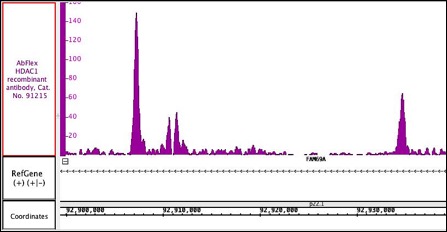AbFlex HDAC1 antibody (rAb)
Host / Isotype
Mouse / IgG2a
Reactivity
Human, Mouse
Applications
ChIP-Seq, WB
Cat No : 91215,91216 91215
Synonyms
验证数据展示
产品信息
| Tested Applications |
ChIP-Seq, WB
Applications Validated by Active Motif: WB*: 0.5 - 2 ug/ml ChIP-Seq: 4 ug per ChIP *Note: many chromatin-bound proteins are not soluble in a low salt nuclear extract and fractionate to the pellet. Therefore, we recommend a High Salt / Sonication Protocol when preparing nuclear extracts for Western Blot. AbFlex recombinant antibodies are genetically derived from DNA sequences of parental hybridoma clones. For details on the parental clone, see Catalog No. 39531. |
| Tested Reactivity | Human, Mouse |
| Host / Isotype | Mouse / IgG2a |
| Class | Recombinant |
| Type | Antibody |
| Immunogen | This antibody was raised against a KLH-conjugated peptide corresponding to amino acids 467-482 of human and murine HDAC1. |
| Full Name | AbFlex HDAC1 antibody (rAb) |
| Synonyms | HDAC1, HDAC 1, HD1, Histone deacetylase, histone acetylation, antibody, antibodies, polyclonal, stem cell, stem cells |
| Molecular weight | 60 kDa |
| GenBank accession number | NP_004955 | RRID | AB_2793807 | Purification Method | Protein A Chromatography |
| Buffer | Purified IgG in 140 mM Hepes, pH 7.5, 70 mM NaCl, 32 mM NaOAc, 0.035% sodium azide, 30% glycerol. Sodium azide is highly toxic. |
| Storage | Some products may be shipped at room temperature. This will not affect their stability or performance. Avoid repeated freeze/thaw cycles by aliquoting items into single-use fractions for storage at -20°C for up to 2 years. Keep all reagents on ice when not in storage. |
背景介绍
AbFlex antibodies are recombinant antibodies (rAbs) that have been generated using defined DNA sequences to produce highly specific, reproducible antibodies. Each AbFlex antibody contains a 6xHis Tag, a Biotinylation Tag for enzymatic biotin conjugation using the biotin ligase, BirA, and a sortase recognition motif (LPXTG) to attach a variety of labels directly to the antibody including fluorophores, enzymatic substrates (HRP, AP), peptides, drugs as well as solid supports. AbFlex HDAC1 antibody was expressed as full-length IgG with mouse immunoglobulin heavy and light chains (IgG2a isotype) in mammalian 293 cells. HDAC1 (Histone Deacetylase 1, also designated HD1) is a member of the class I mammalian histone deacetylases (HDACs) involved in regulating chromatin structure during transcription. These enzymes catalyze the removal of acetyl groups from lysine residues of histones and other cellular proteins. Lysine N-e-acetylation is a dynamic, reversible and tightly regulated protein and histone modification that plays a major role in regulation of gene expression in various cellular functions. It consists of the transfer of an acetyl moiety from an acetyl coenzyme A to the e-amino group of a lysine residue. In vivo, acetylation is controlled by the antagonistic activities of histone acetyltransferases (HATs) and histone deacetylases (HDACs). The HDACs are grouped into four classes, on the basis of similarity to yeast counterparts: HDAC class I (HDAC1, HDAC2, HDAC3 and HDAC8), class II (HDAC4, HDAC5, HDAC6, HDAC7, HDAC9 and HDAC10), class III (SIRT1, SIRT2, SIRT3, SIRT4, SIRT5, SIRT6 and SIRT-7) and class IV (HDAC11). HDAC1 and HDAC2 are recruited to Mad-Max complexes, which associate with the mSin3 scaffold protein, and are required for the transcriptional repression of Mad-Max target genes. HDAC1 is also involved in the regulation of p53. HDAC1 is expressed in various tissues. HDAC1, HDAC2 and HDAC3 are also ubiquitously expressed and can deacetylate both Histone H3 and Histone H4 in free histones or nucleosome substrate.


